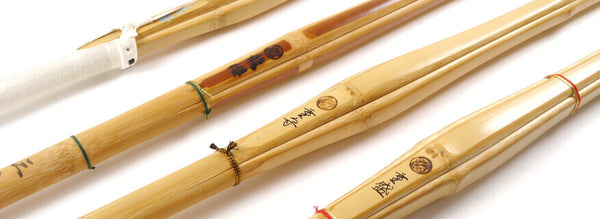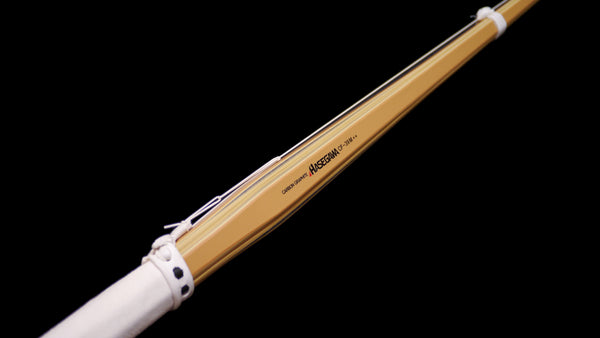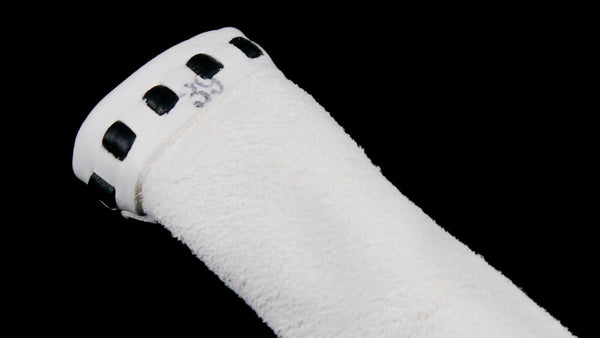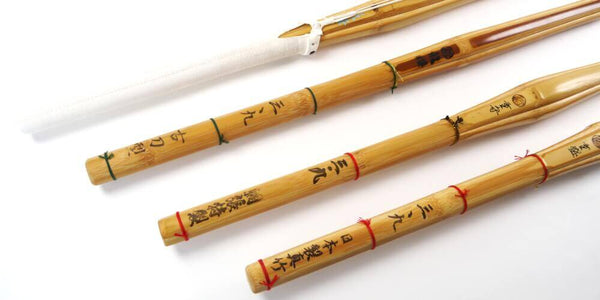Choosing your Kendo Shinai
Size, thickness, weight, bamboo, carbon graphite, etc.
If choosing a Shinai is actually quite simple for a beginner (classic and not too heavy), it is a more complicated task for a confirmed practitioner that needs a weapon adapted to his working style. The weight, the balance, the type of bamboo (or carbon) will greatly influence the behavior of the Shinai and therefore both the qualities developed in training and the possibilities during Shiai (match).

From the left to the right: KuSakura Classic Shinai,Smoked 'Ryuzan', Madake and Dobari
KuSakuraShop offers all types of Shinai whether they are in bamboo or in carbon graphite with the exception of the Kobangata model that does no longer exist within our Shinai line. All our Shinai Keichiku and Madake scrupulously follow the quality standards set throughout the years by KuSakura, Japanese leader in martial arts equipement supply.
Reminder : The Different Parts of a Shinai
The Shinai was originally made from bamboo (Take) Madake from Japan, then later from Keichiku from Japan and Taiwan (for supply reasons, but also for technical reasons). A Shinai generally features 3 parts: the Tsuka (handle), the Do (body, large part above the Tsuba), and the Monouchi (1/3 superior). The leather covering the tsuka is the Tsukagawa (tsuka skin). The guard is called Tsuba, and the rubber retaining ring is called the Tsubadome. The wire used to hold the whole weapon and to maintain the tension between the bamboo slats is called a Tsuru. It is held at its base (Tsuba side) by the Komono (small piece - optional), in the middle by the Nakayui (central knot) and above by the Sakigawa (tip skin). Bamboo knots are called Fushi (they are sometimes given a meaning, but originally there was none). The upper 1/4 between the Nakayui and the Sakigawa is called Datotsubu. it is with this part that you must touch for the cut to be valid (point granted).

The Materials
The Shinai is generally made from Keichiku or Madake Bamboo, but can be carbon graphite made as well. If all shapes/sizes are not available in every material, it is crucial to choose this latest wisely as it will determine the flexibility and the durability of the Shinai. Therefore, the first thing to think of when choosing a Shinai is the material it is made of.
Keichiku or Madake? Which bamboo to take?
Keichiku and Madake are both very specific species of bamboo, both from the Poaceae family, Bambusoideae subfamily, Bambusaeae Shibataeinae tribe . Only the last subgenus, called species, differs, P. bambusoides for the Madake and Phyllostachys makinoi for the Keichiku. Despite their similarities, we can distinguish them through two main characteristics. The Madake has an average diameter from 10 to 15 cm for a size of 15 to 22 m (hence its nickname of the giant bamboo), while the Keichiku does not exceed 9 cm in diameter and 18 m high. It should be noted that the second characteristic, have much more consequence in the manufacturing of a Shinai, especially regarding its resistance/flexibility ratio. A Shinai Madake would be more solid, more durable but less flexible that its Keichiku counterpart. Alternatively, this latest will be more liable to absorb impacts given its improved flexibility but in return, the Shinai's overall durability will be logically impacted. If the Keichiku is native of Taiwan while the Madake seems more specific to Japan, today we can find Keichiku bamboo in Japan, and Madake in Taiwan or in mainland China. Then, it is the drying process and the conception of the Shinai that will make a big difference. A dried, made in Japan Keichiku, in the Japanese tradition will probably be more resistant than a made in Taiwan Madake. Indeed, the Taiwanese bamboos (we will exclude mainland China which really does not make good quality Shinai) are machine dried, which tends to reduce the resilience qualities of the fibers. That being said, today more than 90% of the Shinai used in Japan are Keichiku from Taiwan. Therefore, we can easily concede an excellent average quality of Keichiku Shinai and an excellent price/durability ratio.
- Keichiku : maximum flexibility and average durability.

- Madake : Medium flexibility and a maximum durability. (Remains more flexible than carbon graphite made Shinai)

The Case of Smoked Shinai
Smoked Shinai are called this way due to their smoky appearance visible on the Take (bamboo slats) and their slightly resinous smell. This is due to the treatment they receive during the production process. The slats are first heated at low temperature in order to fill the small pores of the bamboo with its own resin. Consequently, this Shinai tends to be slightly more rigid than its standard counterpart but still more flexible than the carbon graphite made models. Once solidified, this same resin provides the Shinai with better resistance against the harms of humidity enhancing the overall durability of the weapon. If the latest characteristic might seem pointless in some areas, it is actually pretty useful in a country like Japan where the humidity rate can reach 80% in summer and collapse to 20% during winter. This type of Shinai can sometimes be called "Bio" Shinai, but it should be noted that this term does not refer to anything "ecologicaly", "Biologicaly" or "eco-friendly" related, as we can sometimes read on some merchants' website. There is absolutely no ecology notion in the manufacturing process.

The Case of the Carbon Graphite Shinai
The carbon graphite Shinai is quite special. Designed by the Hasegawa high-tech company which president is passionate by Kendo, the company manages to develop, aside from its activities in the chemical industry, a Shinai made from a heart of bamboo covered with carbon fibers and reinforced with a synthetic polymer. Carbon graphite Shinai does not let any splinter as the exterior polymer get worn out little by little like any sort of plastique allowing practitioners not to perform the regular upkeep planing, sanding, oiling. Even though carbon graphite Shinai are 10 times more solid and durable than traditional bamboo Shinai, it should be noted that they are also more rigid making them absorb less vibrations. They do not allow to use the rebound to optimize the speed of the strike. Generally speaking, considering their overall durability, we recommend these Shinai for training sessions as they will not be able to satisfy practitioners who almost exclusively work on openings and who do not use any "feints" or "soft strikes" to take benefit from the rebound strength. Therefore, they also are not recommended for beginners who usually do not have enough muscular strength to absorb vibrations without causing any damages to their articulations in the long run.

The Different Styles of Shinai
5 main styles of Shinai exist and some of them can be combined: Classic, Dobari, Jissengata, Kotogata (or Chokuto) and Kobangata. The shape of the Shinai has a huge impact on the type of practice and on the technical range you will have access to in competition. Most of the time, one would prefer to choose a Kendo Shinai accordingly to its own type of practice.
- Classic: the classic style Shinai is the opposite of the Jissengata style one as it is a traditional which shape has been optimized from the ancient ones (Kotogata). Little by little, the body (Do) has thickened and the balance has been brought down towards the Tsuka in order to get a balanced Shinai, optimized for practice as well as competition. The classic Shinai is considered as the perfect balanced weapon when speaking about speed, strength and flexibility.
- Dobari : literally "Do" the body (trunk) and "Hari", stretched/widened, correspond to a wider body than a classic style Shinai, moving the center of gravity towards the Tsuka. Will allow a better focus on the speed while a slight loss of strength can be noticed.
- Jissengata: literally "shape for real combat", the Jissengata style is closed to the Dobari one, with a large body but with a thinner tip. The reduction of the tip brings the overall center of gravity more down towards the Tsuka, and enable a better focus on speed to the detriment of strength. It must be noted that this style of Shinai is often considered as crippling during practice due to the lack of strength as well as of rebound after a strike. Consequently, this Shinai is without a doubt an expert Kendo weapon.
- Kotogata (also called Chokuto): literally "ancient shape", it corresponds to the very first Shinai produced with a non-optimized balance. The thickness of this style of Shinai is identically allocated over the whole Shinai, the distribution of the weight is equal and the general balance is located around the center of the weapon. These Shinai are well appreciated by high-level teachers who rely more on the Kensen control than on their physical qualities.
- Kobangata: this type of Shinai refers to the shape of the Tsuka (handle), taking the shape of a Koban, an ancient Japanese money coin with an oval shape. An oval larger handle allow a better grip on the Shinai but bring the overall balance way more down towards the Tsuka. These styles of Shinai are usually intended for practitioners with a rather large hand and who need a better grip over the Tsuka.
We can often see some frequent combinations:
- Dobari Jissengata : in fact, it corresponds to a Jissengata (which, as explained above, takes the overall shape of the Dobari.)
- Dobari Kobangata : with a large body and a thick Tsuka, the balance is strongly brought towards the Tsuka and the catch in hand is solid. The are most of the time the heaviest Shinai. Given their overall balance, most Kobangata Shinai are in Dobari style.
Recap of the different styles (balance, recommended usage).
| Picture | Model | Balance | Practice type | Drawbacks | Techniques example |
|---|---|---|---|---|---|
 |
Classic Shinai | Around the Do (Body) | Everything | Classic practice style, without specific personality | All technique. |
 |
Dobari Shinai | On the Tsuba (under the Do) | Speed | Slight loss of strength | Fast strikes. |
 |
Jissengata Shinai | On the Tsuka (handle) | High speed | High loss of strength, a little strength return | Very fast strikes, Koteuchi for example |
 |
Kotogata Shinai | Towards the center | Take of the center | Slow | Kensen control. Technical practice. |
 |
Kobangata Shinai | Towards de Do (body) | Powerful grip of the Tsuka | Generally slightly heavy. | Focus on precision. |
Shinai Fitting
As far as the fitting has been well done, the choice of the fitting pieces do not have any great impact over the practice. Undoubtedly, the most important piece is the Tsukagawa, which is the leather skin covering the handle. The latter can be made of linen (entry line) or most commonly in tanned leather. The Tsukagawa can be hand-sewed, with a simple or double stitching. Although double stitching is more durable, the difference with a classic one is not really evident and the type of stitching has only little effects on the handling of the Shinai.
It should be noted that leather pieces are usually used upside down, the tanned part facing the bamboo so that the part benefit from an optimum grip.

The Shinai weight and size :
If the weight of the Shinai plays a important role in the technique, you actually don't really have the choice as the weight is usually determined by standards implemented in competitions. You may use a heavier Shinai, but, Suburi model apart, they are quite rare as they make the practice more difficult and represent a huge disadvantage in competition.
The size of the Shinai is also regulated according to competition standards, however, as opposed to the weight that is expressed in "minimum weight", the size is determined in "maximum size". Therefore, you can definitely use shorter Shinai. For small Kendoka, so as not to unbalance the strikes, it seems evident that the longer the Shinai is, the easier it is to touch, and especially if the opponent also uses a long Shinai...
De facto, 95% of the men Kendoka use a Shinai in size 39 and a large proportion of women use the size 38. We can also find some 37 sizes in Japan, but as western women tend to be taller, this case is quite unusual. In fact, a lot of western women would use a size 39.
It is important to keep in mind that a shorter Shinai can be used during training, especially if it is more adapted to the morphology of the practitioner (especially for beginners), but during Shiai / competitions, it is quite difficult to fight without a Shinai of the maximum size allowed. All Shinai within KuSakuraShop's line follow competition standards, according to the tab below.
| - | Gender | Junior - 15 years old | Teen 15 to 18 years old | Adult 18 years old + |
|---|---|---|---|---|
| Length | Men Women | Size 37 max (Inf. 114 cm) | Size 38 max (Inf. 117 cm) | Size 39 max (Inf. 120 cm) |
| Weigth | Men | Over 440 g | Over 480 g | Over 510 g |
| Women | Over 400 g | Over 420 g | Over 440 g |
Avoid Bad Habits:
Naturally, you could choose a Shinai for its appearance or for what it represents (tradition above all, I am taking a Kotogata!), but the choice of a Shinai should not rely on what you like or think to like. Actually, you must choose a Shinai according to your practice style, your qualities, your flaws and your techniques.
For instance, you might want to take a Jissengata in order to focus a maximum on your speed, but the lightness of this type of Shinai will force you to strike increasingly faster to the detriment of the precision or of the center taking. As a result, it will make your technique imperfect and eventually, make you take bad habits which would be a serious disadvantage in Shiai.
The other way around, if you tend to focus too hard on your speed and not to work enough on your precision and your take of the center, practicing with a Kotogata will help you to slow down and improve your accuracy and your take of the center.

Roughly speaking, the Shinai is not only a technical tool, but above all, it is a tool to help you fix your flaws and balance your technique.
Quality Labels in a Nutshell
In Japan, two labels exist , the SSP label and the SG label. These labels are extremely different from one another.
Indeed, SSP (standing for Shinai Safety Promotion), implemented by the association of martial arts manufacturers in Japan (Zen Nihon Budogu Kyodo Kumiai) and in collaboration with the Japanese Kendo Federation is a technical label that guarantees official recognition of the Shinai in competition. The Shinai are meticulously controlled, whether it is in terms of safety and quality or in terms of specifities (density, dimensions and so on).
The SG label, standing for Safe Goods, is a much broader "quality label". Not only martial equipements, this label also concerns any potentially dangerous product sold on the Japanese market. Implemented by the government and the Consumers' Unions of Japan, this label guarantees, in any field, a minimum level of quality guaranteeing the use of the product under reasonable safety conditions. The SG Shinai can usually be used in competition in Japan and are widely allowed in all European competitions. However, their standardization is not guaranteed by this label (weight/size ratio for example). Every Shinai sold on KuSakuraShop can be used in competition but, while some are SSP certified, some others only have the SG label.
AA, AAA, AAAA labels, are not recognized in Japan. These labels were invented by Chinese manufacturers and sellers of low quality equipment to distinguish the quality of the bamboo used for their products. We actually do not have a lot of information regarding these specific labels but we can assume that the AAAA is better than the two others... probably of a quality equivalent to some Japanese Shinai. That said, given the danger that represents a low quality Shinai, we do not recommend purchasing this type of Shinai on the Internet. If you would rather get a cheap Shinai, it would be wiser to go directly to a store so you can control by yourself the quality of the bamboo and make certain that the product is safe to use.

Conclusion
In sum, let's keep in mind that this article is only a technical reference guide to help you in your decision. The real sensation of the Shinai once in your hand can significantly change from a practitioner to another depending on its body shape and its technical preferences. Before choosing a style or a model of Shinai, we can only recommend you to try beforehand the Shinai of your Sempai, you may find what you are looking for. A good Kendoka will try every style of Shinai, in several situations before being able to find the one that will allow him to express its art. In short, choosing your Shinai is something personal, something that will vary depending on the practitioner and its experience.


1 comment - The guide to choose your Shinai
looking for a company which I can order Quality Juto GEs